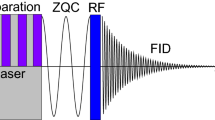Abstract
The role of theory in guiding and simplifying interpretation of electron spin resonance experiments on photochemical and other reactions involving free radical intermediates is surveyed. Emphasis is on models which provide a physical picture as well as quantitative estimates for such phenomena as the radical pair mechanism of chemically induced electron spin polarization (CIDEP), the closely related process of spin exchange during radical-radical encounters, and spin lattice relaxation. Some specific topics discussed are: 1) an improved quantitative model of STo CIDEP combining an initial stage of polarization development followed partial loss of this polarization to spin exchange, 2) the relation between the spin exchange and recombination rate constants, and 3) simplification of spin-lattice relaxation in the common case of spin-rotation relaxation. The modification of the polarization processes in two-dimensional and closed three-dimensional systems is also discussed
Similar content being viewed by others
References
L.R. Dalton, A. Bain, and C.L. Young in H.L. Strauss, G.T. Babcock, and C.B. Moore (Eds.), Annual Reviews of Physical Chemistry, Vol. 41, Annual Reviews, Inc., Palo Alto, 1990, p. 389.
H. Murai, Y. Sakaguchi, H. Hayashi, and Y.J. I’Haya, J. Phys. Chem., 90(1986)113, and references contained therein.
G.L. Closs, M.D.E. Forbes, and J.R. Norris, J. Phys. Chem., 91(1987)3592.
C.D. Buckley, D.A. Hunter, P.J. Hore, and K.A. McLauchlan, Chem. Phys. Letts., 135(1987)307.
L.T. Muus, P.W. Atkins, K.A. McLauchlan, and J.B. Pedersen (Eds.), Chemically Induced Magnetic Polarization, Reidel, Dordrecht, 1977.
E.J. Adrian, Rev. Chem. Intermediates, 7(1986)173, and references contained therein.
T.J. Burkey, J. Lusztyk, K.U. Ingold, J.K.S. Wan, and E.J. Adrian, J. Phys. Chem., 89(1985)4286.
R.P. Feynman, F.L. Vernon, and R.W. Hellwarth, J. Appl. Phys., 28(1957)49.
L. Monchick and F.J. Adrian, J. Chem. Phys, 68(1978)4376.
F.J. Adrian and L. Monchick, J. Chem. Phys., 71(1979)2600; ibid., 72(1980)5786.
J.B. Pedersen and J.H. Freed, J. Chem. Phys., 58(1973)2746.
J.H. Freed and J.B. Pedersen, in J. Waugh (Ed.), Advances in Magnetic Resonance, Vol. 8, Academic, New York, 1975.
A.I. Shushin, Chem. Phys., 144(1960)201.
J.T. dishing, Applied Analytical Mathemaiics for Physical Scientists, Wiley, New York, 1975, pp. 470–486, gives a good discussion of Green’s functions and their derivation.
F.J. Adrian, Chem. Phys. Letts, 80(1981)106.
F.J. Adrian, J. Chem. Phys., 88(1988)3216.
H.S. Carslaw and J.C. Jaeger, The Conduction of Heat in Solids, Oxford U. P., London, 1959, p. 382.
F. J. Adrian, in L.T. Muus, P.W. Atkins, K.A. McLauchlan, and J.B. Pedersen (Eds.), Chemically Induced Magnetic Polarization, Chap. V, Reidel, Dordrecht, 1977.
L. Monchick, J. Chem. Phys., 72(1980)6258.
K. Tominaga, S. Yamauchi, and N. Hirota, J. Chem. Phys., 92(1990)5175.
A.I. Sushin, Chem. Phys. Letts, 177(1991)338.
D.M. Bartells, R.G. Lawler, and A.D. Trifunac, J. Chem. Phys., 83(1985)2686.
G. Nyberg, Mol. Phys., 12(1967)69.
R.F. Curl, Mol. Phys., 9(1965)585.
C.-M. Hu and R. Zwanzig, J. Chem. Phys., 60(1974)4354.
L. Pauling, The Nature of The Chemical Bond, 3rd ed., Cornell, Ithaca, N.Y., 1960, p. 260.
H. Fischer and K.-H. Hellwege (Eds.), Magnetic Properties of Free Radicals, Landolt-Bornstein, Numerical Data and Functional Relationships in Science and Technology, New Ser., Group II, Vol. 1, Springer-Verlag, N.Y., 1965.
S. Basu, K.A. McLauchlan, and A.J.D. Ritchie, Chem. Phys. Letts, 105(1984)447.
Author information
Authors and Affiliations
Additional information
Work supported by the Department of the Navy, Space and Naval Warfare Systems Command under Contract No. N0039-89-C-001.
Rights and permissions
About this article
Cite this article
Adrian, F.J. Theoretical aspects of chemically induced magnetic polarization. Res Chem Intermed 16, 99–125 (1991). https://doi.org/10.1163/156856791X00200
Received:
Accepted:
Issue Date:
DOI: https://doi.org/10.1163/156856791X00200




